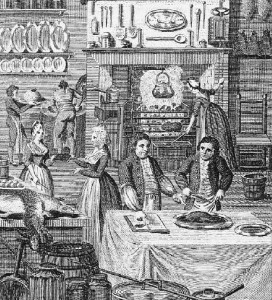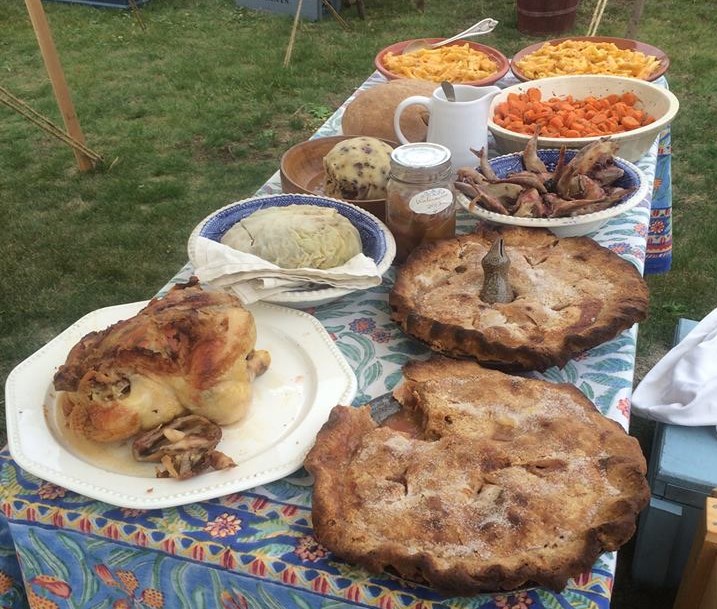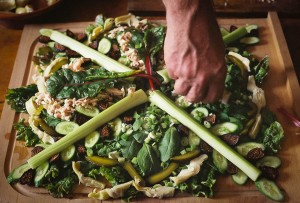Just as very few eyewitness accounts of Grand Portage have survived, there are scarce records of what the partners of the North West Company actually ate at their rendezvous.
A few brief reminiscences about the chief partners venturing forth in suitable style from Montreal to the annual meeting with the wintering partners, but no souvenir menus.
In 1894, a grandson of James Hughes recounted his grandfather’s memories of fur trade rendezvous:
My grandfather always spoke with the most enthusiasm of the festivities at Grand Portage and later at Fort William. … The grave and formal councils were held in alternation with huge feasts and revels. The council hall was converted into the banquet chamber, and the tables groaned under the weight of game of all kinds … garnished and surrounded by various dainties from Montreal prepared and served by experienced cooks. [Reed, Masters of the Wilderness, 1914. pg. 76]
These same lords of the lakes and forest also founded Montreal’s Beaver Club, an exclusive gentleman’s dining club, in 1785. While only fragmentary records remain of their meetings, it is clear that Beaver Club servants plied the members in regular relays with luxuries from the east and the west, and costly delicacies from across the sea.
And so, to understand what the gentlemen of the North West Company might have eaten at rendezvous, we not only need to search deep into day books, account books, letters and manuscripts, we have to read the cookbooks of the time. Fortunately, there are lots. Really. Lots and lots. Luckily, people have written about food since writing was invented.

Frontispiece from William Augustus Henderson, The Housekeeper’s Instructor, 6th edition, c.1800. This same picture appeared in the very first edition of c.1791 and it shows the mistress presenting the cookery book to her servant, while a young man is instructed in the art of carving with the aid of another book.
The earliest cookbooks on record seem to be mainly lists of recipes for what would now be called haute cuisine, and were often written primarily to either provide a record of the author’s favorite dishes or to train professional cooks for banquets and upper-class, private homes. Almost perfect for our purposes!
I have a modest collection of cookbooks, a few old ones (in facsimile) and many more modern, as well as secondary resources related to 18th century foodways. My favorite is The Art of Cookery Made Plain and Easy, by Hannah Glasse.
Called by some modern foodies as the “mother of the modern dinner party,” and “the first domestic goddess,” Glasse was born in 1708, the illegitimate daughter of a prosperous gentleman. Brought up with his family, she witnessed good living and tasted the food of rich country folk.
First published in London in 1747, her book was reprinted within its first year of publication, appeared in 20 editions in the 18th century, and continued to be published until 1843. [Free editions of 1774, 1780, 1784, 1805 are available on Google Books.]
Much like thousands of cooks have discovered in the subsequent 250 years, I find Glasse’s first distinction is simplicity — simple instructions, accessible ingredients, easy recipes and practical help. And from her instructions about “the Order of the Bill of Fare for each Month, in the Manner the dishes are to be placed upon the Table, in the present Taste,” I could fashion the beginnings of a menu. Paired with our list of probable provisions, Glasse gave me a general plan for selecting dishes to cook.
Seven “receipts,” all from Hannah Glasse, nearly a quarter of the dishes cooked on site, in the grand kitchen, at the 2015 Grand Portage rendezvous:
- Carrots Dressed the Dutch Way (1784 edition, page 356)
- Green Pease Soup (1774 edition, page 147)
- A Hunting Pudding (1784 edition, page 137)
- Lemon Cream (1784 edition, page 290)
- To Make a Hedge-Hog (1774 edition, page 164)
- An Onion Pye (1774 edition, page 224)
- Salmagundy (1774 edition, page 116)
Coming soon: Cooking for the gentlemen, Part III . . . what secondary sources can be used to figure out the rest of the menu for our facsimile partner’s dinner at the Grand Portage rendezvous.



The food looks fantastic and tasted Evan better!